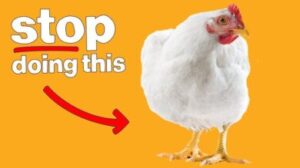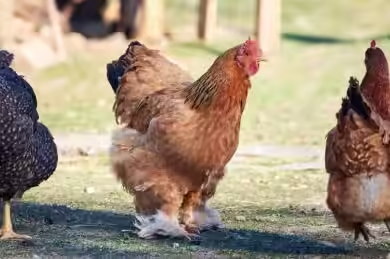Last updated on July 30, 2025
Losing money in Noiler chicken farming is more common than most new farmers expect. I’ve seen it happen to experienced hands and beginners alike—sometimes because of big mistakes, but more often because of small, repeated errors that quietly eat away at profit. If you’re tired of seeing your hard-earned money disappear, you’re not alone. The good news? Most losses are preventable if you know what to watch for and how to fix them.
This guide covers the most common mistakes that make Noiler farmers lose money in Nigeria, and—more importantly—how to avoid them. You’ll find practical, proven strategies, real farmer stories, and expert-backed advice to help you protect your investment and actually grow your poultry profit.
Quick Reference Table: 15 Costly Mistakes, Solutions & Results
| Mistake | How to Avoid | Result |
|---|---|---|
| Guessing feed quantities | Use a feeding chart or scale | Consistent growth, less waste, lower feed costs |
| Using same feed for all ages | Switch to stage-specific feed | Faster growth, better FCR, healthier birds |
| Ignoring feed quality/storage | Buy quality feed, store dry & rodent-free | Better weight gain, fewer health issues |
| Overlooking water quality | Clean waterers daily, test water | Improved feed intake, healthier flock |
| Overcrowded feeders | Provide 2–3 inches feeder space per bird | Uniform flock, faster sales, less fighting |
| Skipping/delaying vaccination | Follow a strict vaccination schedule | Lower mortality, fewer disease outbreaks |
| Neglecting biosecurity | Limit visitors, use footbaths, quarantine new birds | Reduced disease risk, higher survival |
| Ignoring early illness signs | Isolate sick birds, act fast | Prevents spread, saves flock, reduces losses |
| Letting heat stress hurt flock | Provide shade, ventilation, cool water | Maintains growth, reduces deaths in hot season |
| Selling only through middlemen | Build direct customer relationships | Higher profit per bird, loyal buyers |
| Missing peak market demand | Time sales for holidays/festivals | Higher prices, faster turnover |
| Not tracking costs/profits | Keep detailed records | Know your real profit, spot losses early |
| Ignoring dual-purpose (eggs) | Keep hens for eggs as extra income | Steady cash flow, less risk |
| Missing value addition | Process/sell cuts, smoked chicken, etc. | Higher margins, more market options |
| Not learning/adapting | Attend trainings, join farmer groups | Stay competitive, avoid repeating mistakes |
1. Are You Guessing Feed Quantities Instead of Calculating?
Guessing feed amounts is one of the fastest ways to lose money in Noiler farming. Overfeeding wastes expensive feed, while underfeeding slows growth and delays sales. Many farmers simply pour feed until the trough looks full, but this “eyeballing” approach leads to inconsistent results and higher costs.
- Use a feeding chart or calculator (from feed companies or extension services).
- Weigh feed for accuracy, especially in the first 8 weeks.
- Adjust feed as birds grow—don’t use a “one size fits all” approach.
A farmer in Ogun State once told me he used to just “top up” the feeders whenever they looked empty. After he started using a simple feeding chart and weighing feed, he noticed his birds grew more evenly and his feed bill dropped by over ₦30,000 in one cycle.
2. Are You Using the Same Feed Formula for All Ages?
Noiler chickens need different feed formulas at different growth stages. Using the same feed for chicks, growers, and finishers is a costly mistake.
- Chicks (0-4 weeks): High-protein starter feed (20-22% protein).
- Growers (5-8 weeks): 16-18% protein.
- Finishers/Layers (9+ weeks): Feed focused on weight gain or egg production.
If you’re mixing your own feed, get a tested formula from a reputable source or agricultural extension office.
HTS Farms – Day Old Noiler Feed Guide
This guide explains how to match feed to each stage for best results.
3. Are You Ignoring Feed Quality and Storage?
Cheap, low-quality feed or poor storage leads to poor growth, higher feed conversion ratios (FCR), and even health problems. Noilers typically have an FCR ranging from 2.2 to 2.95 kg of feed per 1 kg of weight gain (IDOSR Journals). Poor quality feed or moldy, contaminated feed increases this ratio, meaning you spend more for less growth.
- Store feed in a dry, rodent-proof place.
- Check for mold or off smells before feeding.
- Use airtight containers or metal drums with tight lids.
I once visited a farm where the feed was stored in open bags on a damp floor. The birds refused to eat some of it, and those that did grew slowly and developed diarrhea.
Proper feed storage means healthier birds and better profits.
4. Are You Overlooking Water Quality?
Dirty water reduces feed intake, slows growth, and spreads disease. Birds drink more water than they eat feed, so clean water is non-negotiable for profit.
- Clean waterers daily and check for algae, droppings, or feed debris.
- Test borehole or well water for contaminants at least once a year.
- Change water more often in hot weather to keep it cool and fresh.
For more, see Why Clean Water Is More Important Than Feed in Poultry Farming — you’ll learn why water quality can make or break your flock’s health.
5. Are Your Feeders Overcrowded?
Overcrowding at feeders means weaker birds get pushed aside, grow slower, and you end up with an uneven flock. This delays sales and increases costs.
- Provide at least 2–3 inches of feeder space per bird.
- Add more feeders or spread them out if you notice fighting or uneven growth.
More feeder space = more uniform growth and faster sales.
6. Are You Skipping or Delaying Vaccination?
Missing or delaying vaccinations is a critical error that can wipe out your flock and your profit. Vaccines are a small cost compared to the losses from a disease outbreak.
“Newcastle Disease and Infectious Bursal Disease (Gumboro) are among the most dreaded viral diseases for poultry in Nigeria, causing significant losses.”
— PubMed Central – Evaluating Disease Threats to Poultry in Nigeria
- Work with a local vet or extension officer to set a vaccination schedule.
- Mark vaccination dates on your calendar and don’t skip them.
For a full health management plan, see Forget Drugs: How to Keep Your Noilers Naturally Healthy & Profitable — this article covers natural and preventive health strategies.
7. Are You Neglecting Biosecurity?
Allowing visitors, not cleaning equipment, or failing to control rodents and wild birds are all ways diseases enter your farm. Poor biosecurity is a leading cause of outbreaks.
- Use footbaths at entry points.
- Limit visitors and require clean footwear.
- Quarantine new birds for at least two weeks.
- Control rodents and wild birds.
Good biosecurity means fewer disease outbreaks and higher survival rates.
8. Are You Ignoring Early Signs of Illness?
Chickens hide illness well. By the time a bird looks sick, others may already be infected. Early detection and isolation can save your flock and your profit.
Watch for:
- Lethargy or inactivity
- Loss of appetite
- Ruffled feathers
- Unusual droppings (diarrhea, bloody, watery)
- Coughing, sneezing, or open-mouth breathing
- Swelling of the head, comb, wattles, or eyes
- Pale or discolored comb and wattles
- Lack of coordination or paralysis
- Sudden death without prior symptoms
If you spot a sick bird, isolate it immediately and consult a vet or experienced farmer.
Catching illness early can save your entire flock.
9. Are You Letting Heat Stress Hurt Your Flock?
High temperatures reduce appetite, slow growth, and can even kill birds. Noilers are hardy, but heat stress is still a real risk.
- Provide shade and good airflow in the coop.
- Give plenty of cool water, especially in hot weather.
- Watch for panting, wings held away from the body, and lethargy.
- Sprinkle water on the floor or use fans if possible.
Preventing heat stress keeps your birds growing and reduces losses in hot season.
10. Are You Selling Only Through Middlemen?
Relying only on middlemen means you lose a cut of your profit. Building direct relationships with customers (neighbors, restaurants, local businesses) can double your margin.
- Start small—sell a few birds or eggs directly and build your customer base over time.
- Use WhatsApp, Facebook, or local groups to let people know when you have birds or eggs for sale.
- Offer home delivery or farm-gate pickup for extra convenience.
A farmer in Lagos started selling dressed chickens directly to local restaurants. His profit margin nearly doubled compared to selling only through market traders.
Direct sales can double your profit per bird.
11. Are You Missing Peak Market Demand?
Selling when demand is low means lower prices and longer feeding costs. Plan your production so birds are ready for Christmas, Easter, Salah (Eid al-Adha), and other festive periods when prices spike.
- Check local market calendars for peak demand periods.
- Stagger your production cycles to have birds ready for holidays.
- Monitor prices weekly to spot trends.
Grinphield – How To Sell Your Chickens During Festive Periods — this guide explains how to plan your sales for the best prices.
12. Are You Failing to Track Costs and Profits?
If you don’t know your unit costs, you’re flying blind. Many farmers don’t track feed, medicine, or labor costs, so they don’t know if they’re making or losing money.
- Use a notebook, spreadsheet, or app to track every expense and sale.
- Calculate your cost per bird and per egg.
- Review your records monthly to spot losses or opportunities.
One farmer I know started tracking every bag of feed and every egg sold, and within two months, he realized he was underpricing his eggs and losing money.
Tracking costs is the foundation of a profitable poultry business.
13. Are You Ignoring the Dual-Purpose Potential of Noilers?
Many farmers sell all their Noilers for meat and forget that hens can lay 150–200 eggs per year. Keeping some hens for eggs adds a steady income stream and reduces risk. Eggs can be sold daily or weekly, providing cash flow even when meat sales are slow.
- Keep a portion of your hens for egg production.
- Market eggs directly to neighbors or local shops.
- Track egg sales separately from meat sales for better planning.
14. Are You Missing Out on Value Addition?
Selling only live or whole birds limits your profit. Processing birds into cuts, smoked chicken, or sausages can fetch higher prices and attract new customers. Even simple packaging or offering home delivery can set you apart in your local market.
- Offer smoked chicken, chicken parts, or marinated cuts.
- Partner with a local processor if you don’t have equipment.
- Promote value-added products on social media or at local markets.
A study by the University of Nigeria, Nsukka, highlighted how value addition in poultry can lead to better returns for smallholder farmers (UNN).
Value addition can increase your profit per bird by 20–40%.
15. Are You Failing to Keep Learning?
Poultry farming is always changing. Farmers who don’t seek new knowledge, attend trainings, or adapt to market trends are more likely to repeat costly mistakes. I’ve seen farmers who stick to the same methods for years, even as feed prices, disease risks, and market demand change.
- Join farmer groups and WhatsApp communities.
- Attend local workshops and extension trainings.
- Follow reliable sources like FAO or your local extension office.
- Try new ideas on a small scale before expanding.
Continuous learning keeps your farm competitive and profitable.
Key Takeaways
- Calculate feed, don’t guess.
- Use stage-specific feed for each age group.
- Store feed properly and buy quality.
- Clean water is as important as feed.
- Avoid overcrowding at feeders.
- Never skip or delay vaccinations.
- Practice strict biosecurity.
- Catch illness early and act fast.
- Prevent heat stress with shade and water.
- Build direct sales channels, not just middlemen.
- Time your sales for peak demand.
- Track every cost and sale.
- Use Noilers for both meat and eggs.
- Add value to your products.
- Keep learning and adapting.
My Experience
When I started, I lost money by guessing feed, skipping records, and selling only through middlemen. Once I started tracking costs, using a feeding chart, and selling eggs directly to neighbors, my profit turned around. Most farmers I know who succeed with Noilers are the ones who keep learning and adapt fast.
Tracking, learning, and direct sales turned my losses into profit.
FAQ
What is the biggest expense in Noiler farming?
Feed is typically the largest expense, often 60–70% of total costs.
How important is vaccination for Noilers?
Extremely important. It protects your flock from devastating diseases and prevents high mortality.
When is the best time to sell Noiler chickens in Nigeria?
Peak seasons: Christmas, New Year, Easter, Salah (Eid al-Adha), and other festivals.
Can Noilers lay eggs?
Yes, hens can lay 150–200 eggs per year.
Why is tracking farm expenses important?
It helps you know your real profit, spot losses, and make better decisions.
How much profit can I expect per bird if I avoid these mistakes?
On average, well-managed Noiler farms in Nigeria report profits of ₦1,500–₦3,000 ($1–$2) per bird, depending on feed prices and market timing.
What’s the best way to start if I’m new?
Start small (e.g., 10–50 birds), keep detailed records, and focus on learning before scaling up.
Conclusion
Profitable Noiler farming isn’t about luck—it’s about smart management and avoiding costly errors. By focusing on feed, health, sales, and record-keeping, you can protect your investment and build a sustainable poultry business. Every mistake is a lesson—learn, adapt, and keep moving forward.
If you have a specific question or want to share your own experience, drop it in the comments below. Let’s help each other succeed!
Recommended Reading / Next Steps
- 13 Hidden Disadvantages of Noiler Chickens — Learn the risks and how to solve them.
- 7 Ways to Boost Profitability in Your Noiler Chicken Farm — Actionable tips to increase your profit.
- How to Make Noiler Grow Fast — Proven strategies for faster, healthier growth.
- Is Noiler Chicken Profitable in Nigeria? — Real cost and income breakdowns.
- Forget Drugs: How to Keep Your Noilers Naturally Healthy & Profitable — Natural health management for your flock.
- How to Save Money on Broiler Feed Without Cutting Corners — Feed-saving tips that work for Noilers too.
- Noiler Chicken vs Broiler Chicken — Full comparison of breeds for Nigerian farmers.
- Noiler Chicken Price in Nigeria — Up-to-date market prices and trends.
- Why Clean Water Is More Important Than Feed in Poultry Farming — The science behind water and flock health.
- Must-Have Medications for Broiler Chicks — Essential medicines for healthy chicks.


